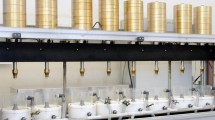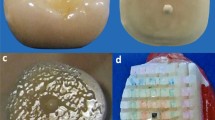Abstract
Statement of Problem: Wear of complete denture teeth results in compromise in denture esthetics and functions. To counteract this problem, artificial teeth with increased wear resistance had been introduced in the market such as nanocomposite teeth. Purpose: The purpose of this study was to compare the amount of wear between nanocomposite teeth and acrylic teeth. Materials and methods: Fifteen specimens were chosen from each group namely the nanocomposite teeth (SR_-PHONARES) and the acrylic teeth (ACRY PLUS). Maxillary premolar was only chosen for testing and the samples were customized according to the specifications of the pin on disc machine. Pin on disc machine is a two body tribometer which quantifies the amount of wear under a specific load and time. Test samples were mounted on to the receptacle of the pin on disc machine and tested under a load of 0.3 kg for 1,000 cycles of rotation against a 600 grit emery paper. The amount of wear is displayed from the digital reading obtained from the pin on disc machine. Results: After statistical analysis, it was found that, the amount of wear is more in four layered acrylic teeth. The p value obtained is 0.002 (<0.005) thus implies that the difference in wear between nanocomposite teeth and acrylic teeth is statistically significant. Conclusion: Though the nanocomposite teeth has less amount of wear than the four layered acrylic teeth, the difference is very less and adds only to a little clinical significance but the cost of the nanocomposite is four times that of the acrylic teeth. Further clinical studies must be performed to confirm our results.






Similar content being viewed by others
References
Winkler S (2012) Essentials of complete denture Prosthodontics, 2nd edn. ATIBS, Delhi, p 222
Kim SK, Kim KN, Chang IT, Heo SJ (2001) A study of the effects of chewing patterns on occlusal wear. J Oral Rehabil 28:1048–1055
Reis KR, Bonfante G, Pegoraro LF, Conti PC, Oliveira PC, Kaizer OB (2008) In vitro wear resistance of three types of polymethyl methacrylate denture teeth. J Appl Oral Sci 16(3):176–180
CANDULOR. Porcelain teeth is still available! (2011). http://www.candulor.us/fileadmin/produktbilder/C. Accessed 16 Feb 2014
Ohlmann B (2007) Influences on clinical wear of acrylic denture teeth: a Pilot study. Int J Prosthodont 20:496–498
Chang JC, Katz ST (1994) Composite denture teeth made on a removable partial metal framework. J Prosthet Dent 71(4):409–412
Craig RG, Powers JM (2002) Restorative dental materials, 11th edn. Mosby, Missouri, p 672
Heintze SD et al (2012) Laboratory methods for evaluating the wear of denture teeth and their correlation with clinical results. Dent Mater 28:261–272
Suzuki S (2004) In vitro wear of nano-composite denture teeth. J Prosthodont 13:238–243
Hahnel S, Behr M, Handel G, Rosentritt M (2009) Two- body wear of artificial acrylic and composite resin teeth in relation to antagonist material. J Prosthet Dent 101:269–278
Coffey JP, Goodkind RJ, DeLong R, Douglas WH (1985) In vitro study of wear characteristics of natural and artificial teeth. J Prosthet Dent 54:273–280
Ogle RE, Davis EL (1998) Clinical wear of three commercially available artificial tooth materials: thirty-six month results. J Prosthet Dent 79:145–151
Ghazal M, Kern M (2010) Wear of denture teeth and their human enamel antagonists. Quintessence Int 41(2):157–163
Zarb GA (2004) Prosthodontic Treatment for edentulous patients, 12th edn. Mosby, Missouri, p 16
Zhou ZR, Zheng J (2008) Tribology of dental materials: a review. J Phys D Appl Phys 41(11):1–22
Heintze SD, Faouzi M, Rousson V, Ozcan M (2012) Correlation of wear in vivo and six laboratory wear methods. Dent Mater 28(9):961–973
Lambrechts P, Debels E, Landuyt KV, Pneumans M, Meerbeek BV (2006) How to simulate wear? Overview of existing methods. Dent Mater 22:693–701
Powers JM, Fan PL, Craig RG (1981) Wear of dental restorative resins. Biomed Dent Appl Polym 14:453–457
Heintze SD (2006) How to qualify and validate wear simulation devices and methods. Dent Mater 22(8):712–734
Harrison A, Lewis TT (1975) The development of an abrasion testing machine for dental materials. J Biomed Mater Res 9(3):341–353
Stober et al (2010) Three body wear of resin denture teeth with and without nanofillers. J Prosthet Dent 103:108–117
Ghazal M, Hedderich J, Kern M (2008) Wear of feldspathic ceramic, nano-filled composite resin and acrylic resin artificial teeth when opposed to different antagonists. Eur J Oral Sci 116(6):585–592
Reis KR, Bonfante G, Pegoraro LF, Conti PC, Oliveira PC, Kaizer OB (2008) In vitro wear resistance of three types of polymethyl methacrylate denture teeth. J Appl Oral Sci 16(3):176–180
Loyaga-Rendon PG, Takahashi H, Hayakawa I, Iwasaki N (2007) Compositional characteristics and hardness of acrylic and composite resin artificial teeth. J Prosthet Dent 98(2):141–149
Ghazal M, Kern M (2009) Wear of human enamel and nano-filled composite resin denture teeth under different loading forces. J Oral Rehabil 36(1):58–64
Ghazal M, Kern M (2009) The influence of antagonistic surface roughness on the wear of human enamel and nanofilled composite resin artificial teeth. J Prosthet Dent 101(5):342–349
Author information
Authors and Affiliations
Corresponding author
Electronic supplementary material
Below is the link to the electronic supplementary material.
Rights and permissions
About this article
Cite this article
Ilangkumaran, R., Srinivasan, J., Baburajan, K. et al. Two Body Wear of Newly Introduced Nanocomposite Teeth and Cross Linked Four Layered Acrylic Teeth: a Comparitive In Vitro Study. J Indian Prosthodont Soc 14 (Suppl 1), 126–131 (2014). https://doi.org/10.1007/s13191-014-0381-z
Received:
Accepted:
Published:
Issue Date:
DOI: https://doi.org/10.1007/s13191-014-0381-z




